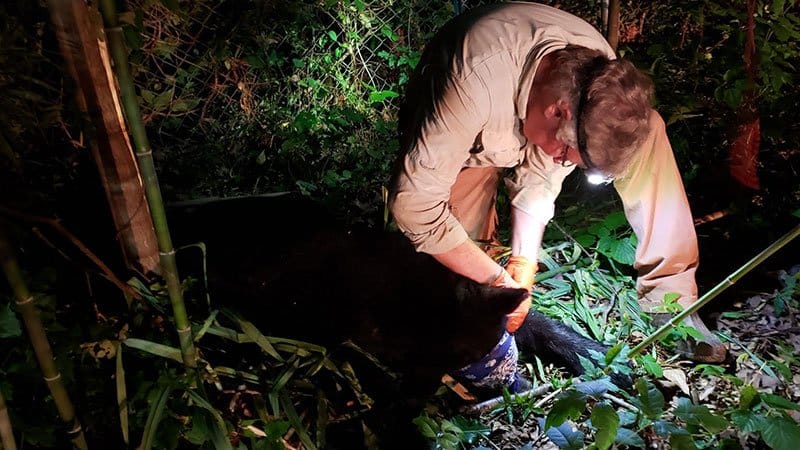Bear removal in White Hall reminds Arkansans to be “Bear Aware”
ON 05-06-2020

May 6, 2020
Randy Zellers
Assistant Chief of Communications

PINE BLUFF — Residents of a White Hall neighborhood had an early awakening Sunday morning as authorities responded to a call about a large black bear that had climbed into a tree nearby and had to be removed.
Mark Hooks, wildlife management supervisor for the Arkansas Game and Fish Commission, said the best course of action during similar situations is to clear an area and allow a bear to come down on its own, but that was not an option in this case.
“We really do not like removing bears from heights like this because of possible injury to the bear or the men and women working, but local authorities felt that the animal was too close to nearby homes to allow it to climb down and move off on its own,” Hooks said. “So we had to use a tranquilizer to sedate and relocate the bear, which was about 60 feet in the tree.”
Hooks and fellow wildlife biologists David Luker and Mark Barbee worked to sedate the bear, while Wildlife Officer Onezean Ravenell and Enforcement Sergeant Phillip Livingston worked with the White Hall Police Department to secure the area.
“Unfortunately the bear became lodged in some branches while it was still in the tree, so we called a local fire department to use their ladder truck,” Hooks said.
The use of the ladder truck was unsuccessful, but as the animal’s weight shifted it dropped into a small shrubby tree, which softened its fall.
“The bear was moved to a remote location, tagged and its vitals were monitored until the effects of the tranquilizer wore off,” Hooks said. “It showed no apparent injury from the fall as it left the release site.”
The particular bear causing last weekend’s commotion was a large male, estimated at 3 years or older, but this time of year tends to be when the AGFC fields many nuisance bear complaints. In almost all of these cases, the offending animal is a young male bear that finds its way into trouble after leaving its mother behind. Female bears will spend two winters with their cubs: the first when they are newborns, and the second as adolescents. In their second year, female cubs will be allowed to stay in a portion of their mother’s territory, but male bears are forced away to find a new home on their own.
“It’s nature’s way of ensuring genetic diversity,” said Myron Means, bear program coordinator for the AGFC. “The young males will wander for a while until they find a new home with good food resources.”
Unfortunately, that search may land young bears in some sticky situations with homeowners and businesses near bear country. Open trash cans, bowls filled with pet food and areas where people have dumped cooking grease or table scraps often attract these wayward bears. Wildlife feeders also act as magnets to these young bruins, who will take advantage of the free meal.
“The first thing we tell anyone to do when they have a nuisance bear in the area is to put away any possible foods, including deer feeders, bird feeders and dog food, and to keep trash cans locked or put away where they are inaccessible for a couple of days,” Means says. “That usually is all it takes for the bear to move on.”
Just like grandpa always told you about snakes and other scary critters, bears are much more scared of people than we are of them. But if a bear is allowed to stick around, it can begin to associate people with a free meal, and that’s when trouble starts. Means suggests people who see bears where they don’t want them make it clear it needs to move on.
“Making noise, yelling and throwing a rock or two at the bear will give it the message that it’s not welcome,” Means said. “Bears aren’t aggressive animals and they don’t have a desire for revenge or anything. They just realize the area isn’t comfortable to stay in and will go away.”
More information about bear awareness and bear safety can be found on the cooperative website www.Bearwise.org. This site was developed by bear biologists throughout the Southeast and includes information specific to Arkansas.
Recent News

Arkansas Wildlife Weekly Fishing Report
Jul. 10, 2025

Lonoke aquaculturist named to AGFC
Jul. 10, 2025
Subscribe to Our Weekly Newsletter E-mails
Don’t miss another issue. Sign up now to receive the AGFC Wildlife Weekly Newsletter in your mailbox every Wednesday afternoon (Waterfowl Reports are published weekly during waterfowl season and periodically outside the season). Fishing Reports arrive on Thursdays. Fill in the following fields and hit submit. Thanks, and welcome!
